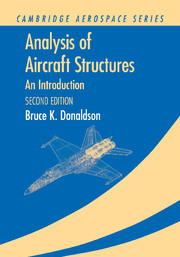Book contents
- Frontmatter
- Contents
- Introduction to the Second Edition
- Introduction to the First Edition
- List of Repeated Engineering Symbols
- Acknowledgments
- Part I The Fundamentals of Structural Analysis
- Part II **Introduction to the Theory of Elasticity**
- Part III Engineering Theory for Straight, Long Beams
- Part IV Work and Energy Principles
- Part V Energy-Based Numerical Solutions
- Part VI Thin Plate Theory and Structural Stability
- Appendix A Additional Topics
- Appendix B Selected Answers to Exercises
- References
- Index
Part IV - Work and Energy Principles
Published online by Cambridge University Press: 05 June 2012
- Frontmatter
- Contents
- Introduction to the Second Edition
- Introduction to the First Edition
- List of Repeated Engineering Symbols
- Acknowledgments
- Part I The Fundamentals of Structural Analysis
- Part II **Introduction to the Theory of Elasticity**
- Part III Engineering Theory for Straight, Long Beams
- Part IV Work and Energy Principles
- Part V Energy-Based Numerical Solutions
- Part VI Thin Plate Theory and Structural Stability
- Appendix A Additional Topics
- Appendix B Selected Answers to Exercises
- References
- Index
Summary
Preface
There is only one chapter in Part IV so as to emphasize the important role work and energy principles play in modern structural analysis. Every chapter past this one depends upon the material of this chapter. The content of this chapter admittedly will be challenging to all those who have not had any previous experience with this material. For the student, the concept of work is not likely to have had a particularly prominent place in prior studies. The concept of potential energy is likely to have made a previous appearance only in relation to the gravitational potential. The calculus of variations, a key aspect of this chapter, is likely to be entirely new to the student (be sure to read Endnote (1)). Obviously in this chapter there are abundant opportunities for intellectual growth. In order to take advantage of those opportunities, the Green–Gauss theorem must be mastered. The next section provides a review of that theorem.
The Green–Gauss Theorem
Consider a closed area A on an x plane such as shown in Fig. IV.1(a). Let this area be such that any line paralleling the z axis cuts ∂A, the piecewise smooth boundary of A, only twice. Let the various boundary segments that comprise the total boundary be divided into a lower and upper curve which meet at the points y = a and y = b, where those points are the minimum and maximum y values on the boundary. In the case illustrated in Fig. IV.1, the “point” y=a is actually a line segment.
Information
- Type
- Chapter
- Information
- Analysis of Aircraft StructuresAn Introduction, pp. 475 - 478Publisher: Cambridge University PressPrint publication year: 2008
